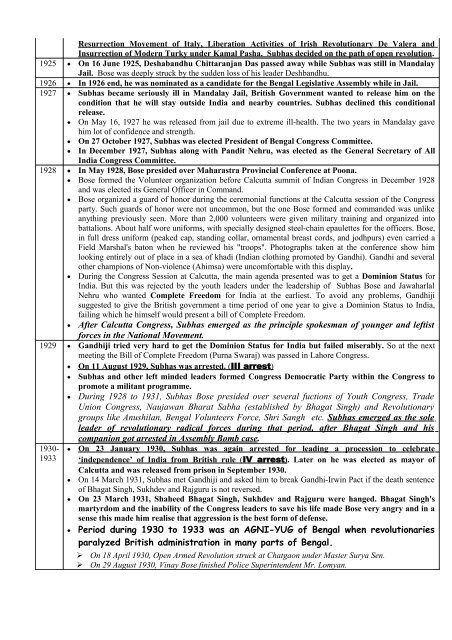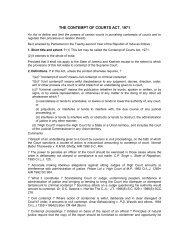You also want an ePaper? Increase the reach of your titles
YUMPU automatically turns print PDFs into web optimized ePapers that Google loves.
1925 •<br />
Resurrection Movement of Italy, Liberation Activities of Irish Revolutionary De Valera and<br />
Insurrection of Modern Turky under Kamal Pasha. Subhas decided on the path of open revolution.<br />
On 16 June 1925, Deshabandhu Chittaranjan Das passed away while Subhas was still in Mandalay<br />
Jail. Bose was deeply struck by the sudden loss of his leader Deshbandhu.<br />
1926 • In 1926 end, he was nominated as a candidate for the Bengal Legislative Assembly while in Jail.<br />
1927 • Subhas became seriously ill in Mandalay Jail, British Government wanted to release him on the<br />
condition that he will stay outside India and nearby countries. Subhas declined this conditional<br />
release.<br />
• On May 16, 1927 he was released from jail due to extreme ill-health. The two years in Mandalay gave<br />
him lot of confidence and strength.<br />
• On 27 October 1927, Subhas was elected President of Bengal Congress Committee.<br />
• In December 1927, Subhas along with Pandit Nehru, was elected as the General Secretary of All<br />
India Congress Committee.<br />
1928 • In May 1928, Bose presided over Maharastra Provincial Conference at Poona.<br />
• Bose formed the Volunteer organization before Calcutta summit of Indian Congress in December 1928<br />
and was elected its General Officer in Command.<br />
• Bose organized a guard of honor during the ceremonial functions at the Calcutta session of the Congress<br />
party. Such guards of honor were not uncommon, but the one Bose formed and commanded was unlike<br />
anything previously seen. More than 2,000 volunteers were given military training and organized into<br />
battalions. About half wore uniforms, with specially designed steel-chain epaulettes for the officers. Bose,<br />
in full dress uniform (peaked cap, standing collar, ornamental breast cords, and jodhpurs) even carried a<br />
Field Marshal's baton when he reviewed his "troops". Photographs taken at the conference show him<br />
looking entirely out of place in a sea of khadi (Indian clothing promoted by Gandhi). Gandhi and several<br />
other champions of Non-violence (Ahimsa) were uncomfortable with this display.<br />
• During the Congress Session at Calcutta, the main agenda presented was to get a Dominion Status for<br />
India. But this was rejected by the youth leaders under the leadership of Subhas Bose and Jawaharlal<br />
Nehru who wanted Complete Freedom for India at the earliest. To avoid any problems, Gandhiji<br />
suggested to give the British government a time period of one year to give a Dominion Status to India,<br />
failing which he himself would present a bill of Complete Freedom.<br />
• After Calcutta Congress, Subhas emerged as the principle spokesman of younger and leftist<br />
forces in the National Movement.<br />
1929 • Gandhiji tried very hard to get the Dominion Status for India but failed miserably. So at the next<br />
meeting the Bill of Complete Freedom (Purna Swaraj) was passed in Lahore Congress.<br />
• On 11 August 1929, Subhas was arrested. ( III arrest)<br />
• Subhas and other left minded leaders formed Congress Democratic Party within the Congress to<br />
promote a militant programme.<br />
• During 1928 to 1931, Subhas Bose presided over several fuctions of Youth Congress, Trade<br />
Union Congress, Naujawan Bharat Sabha (established by Bhagat Singh) and Revolutionary<br />
groups like Anushilan, Bengal Volunteers Force, Shri Sangh etc. Subhas emerged as the sole<br />
leader of revolutionary radical forces during that period, after Bhagat Singh and his<br />
companion got arrested in Assembly Bomb case.<br />
1930- • On 23 January 1930, Subhas was again arrested for leading a procession to celebrate<br />
1933 ‘independence’ of India from British rule ( IV arrest)<br />
. Later on he was elected as mayor of<br />
Calcutta and was released from prison in September 1930.<br />
• On 14 March 1931, Subhas met Gandhiji and asked him to break Gandhi-Irwin Pact if the death sentence<br />
of Bhagat Singh, Sukhdev and Rajguru is not reversed.<br />
• On 23 March 1931, Shaheed Bhagat Singh, Sukhdev and Rajguru were hanged. Bhagat Singh's<br />
martyrdom and the inability of the Congress leaders to save his life made Bose very angry and in a<br />
sense this made him realise that aggression is the best form of defense.<br />
• Period during 1930 to 1933 was an AGNI-YUG of Bengal when revolutionaries<br />
paralyzed British administration in many parts of Bengal.<br />
� On 18 April 1930, Open Armed Revolution struck at Chatgaon under Master Surya Sen.<br />
� On 29 August 1930, Vinay Bose finished Police Superintendent Mr. Lomyan.




